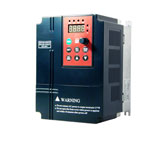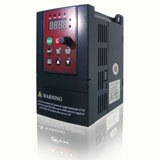Does the motor lifetime depend on the starts number & frequency?
Both AC and DC machines starting on variable frequency drives do not have a maximum number of start attempts over the life of the machine provided the variable frequency drive programming and protection mechanisms limits the amount of current drawn during the transient period to a reasonable (below 1.25 per unit) value.
There MAY be a limit on the number of consecutive start attempts in a short period of time, based on thermal stress applied to the motor windings. This assumes the current during the start is limited, but to something slightly more than the rated full load value. If there is only ever 100 percent rated current, the issue is nonexistent.
For machines starting across the line (or on an autotransformer), where the current drawn is significantly higher than the full load rating, there are limits imposed on the "lifetime" limit and on the number of consecutive starts in a short period. For most instances, a typical "lifetime" limit is around 5000 starts - this comes from estimating a start attempt every 36-40 hours for a 10 year period. The "standard" for consecutive start attempts is often defined as two cold / one hot / maximum 6 in 24 hours. "Cold", in this case, refers to having ALL the parts of the machine at room temperature. Any other condition is considered to be "hot".
Typically, the installation / commissioning period sees a high number of start attempts - the system is being tuned to operate correctly. After the process is operating as designed, the number of start attempts drops off dramatically, only edging up when there has been a shutdown (either planned or emergency).
The limitation for non-drive-source starts is essentially a thermal limit, resulting in potential fatiguing of internal parts of the machine (for example, the cage / bar joint). Each manufacturer can - and will - supply any applicable starting limitations for their own equipment, if asked.
Note that one other thing may limit the number of start attempts - either lifetime or in a short period. That would be the inertia of the drive train to which they are connected. If the load inertia is too high, the current drawn will either be too high or the acceleration period will extend too long; both of these can result in thermal damage to the machine windings. (This is ALSO true for a VFD start, if the VFD ramp is designed for a peak current in excess of the machine full load nameplate rating.)
A water resistance brake would effectively introduce load and relieve it. Once started, any other stresses would have to be considered in comparison to the motor's nominal rating. Focus on evaluating it by looking at current in the motor.
There MAY be a limit on the number of consecutive start attempts in a short period of time, based on thermal stress applied to the motor windings. This assumes the current during the start is limited, but to something slightly more than the rated full load value. If there is only ever 100 percent rated current, the issue is nonexistent.
For machines starting across the line (or on an autotransformer), where the current drawn is significantly higher than the full load rating, there are limits imposed on the "lifetime" limit and on the number of consecutive starts in a short period. For most instances, a typical "lifetime" limit is around 5000 starts - this comes from estimating a start attempt every 36-40 hours for a 10 year period. The "standard" for consecutive start attempts is often defined as two cold / one hot / maximum 6 in 24 hours. "Cold", in this case, refers to having ALL the parts of the machine at room temperature. Any other condition is considered to be "hot".
Typically, the installation / commissioning period sees a high number of start attempts - the system is being tuned to operate correctly. After the process is operating as designed, the number of start attempts drops off dramatically, only edging up when there has been a shutdown (either planned or emergency).
The limitation for non-drive-source starts is essentially a thermal limit, resulting in potential fatiguing of internal parts of the machine (for example, the cage / bar joint). Each manufacturer can - and will - supply any applicable starting limitations for their own equipment, if asked.
Note that one other thing may limit the number of start attempts - either lifetime or in a short period. That would be the inertia of the drive train to which they are connected. If the load inertia is too high, the current drawn will either be too high or the acceleration period will extend too long; both of these can result in thermal damage to the machine windings. (This is ALSO true for a VFD start, if the VFD ramp is designed for a peak current in excess of the machine full load nameplate rating.)
A water resistance brake would effectively introduce load and relieve it. Once started, any other stresses would have to be considered in comparison to the motor's nominal rating. Focus on evaluating it by looking at current in the motor.



